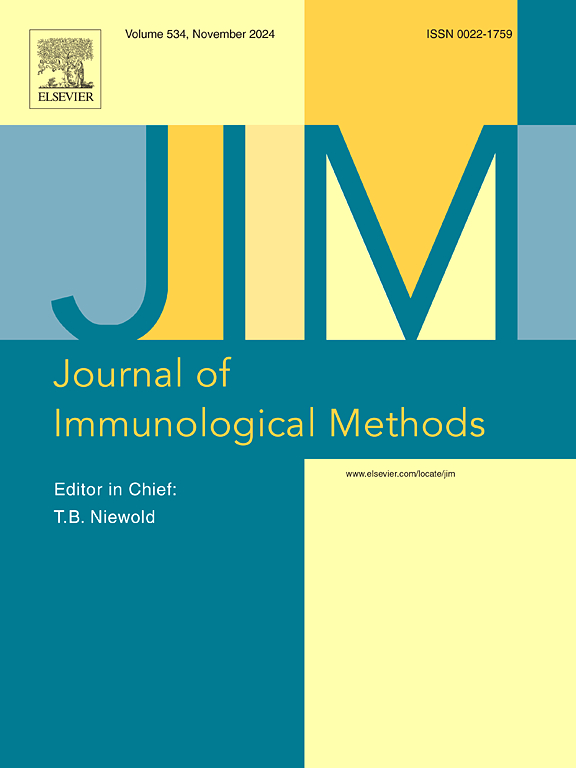自采干血斑点检测SARS-CoV-2核衣壳抗体敏感性低。
IF 1.6
4区 医学
Q4 BIOCHEMICAL RESEARCH METHODS
引用次数: 0
摘要
背景和目的:干血点(DBS)已被提出作为一种具有成本效益的监测方法,用于筛查人群对SARS-CoV-2的免疫,但基于自行采集的DBS样本的DBS敏感性尚不清楚。为了评估疫苗接种策略的成功与否,有必要将疫苗接种与自然感染区分开来。因此,需要对病毒核衣壳蛋白(anti-N)进行抗体检测。材料和方法:在瑞士东部前瞻性随访的医护人员(HCW)队列中,我们从2020年3月至9月每两周使用DBS评估sars - cov -2抗n血清阳性率。3月和9月采集血样,检测抗n血清阳性,以及SARS-CoV-2刺突抗体进行定量验证。采用罗氏Elecsys电化学发光免疫分析法将静脉抗体检测与DBS结果进行比较。结果:纳入792例HCW,中位年龄38.3岁,35例(4.4%)sars - cov -2抗n血清阳性。在43例匹配的DBS中,25例检测出抗n阳性,敏感性为58.1% (95% CI为43.3- 71.6%)。结论:尽管在更大的队列中,家庭DBS采集是可行的,并且我们发现DBS中抗n检测与采血样本之间存在高度相关性,但自行采集的DBS样本对罗氏Elecsys抗n检测的敏感性明显受损。因此,当可以从静脉血中进行测试时,我们不推荐这种方法用于DBS。本文章由计算机程序翻译,如有差异,请以英文原文为准。
Evaluation of self-collected dried blood spots for detection of SARS-CoV-2 nucleocapsid antibodies shows low sensitivity
Background and aims
Dried blood spots (DBS) have been proposed as a cost-effective surveillance method for population-wide screening of SARS-CoV-2 immunity but sensitivity of DBS based on self-collected DBS samples is unknown. To evaluate the success of vaccination strategies, it is necessary to differentiate vaccination from natural infection. Therefore, a test for antibodies against the viral nucleocapsid protein (anti-N) is desirable.
Materials and methods
In our prospectively followed cohort of healthcare workers (HCW) in eastern Switzerland, we assessed SARS-CoV-2-anti-N-seroprevalence using DBS on a biweekly basis from March to September 2020. Phlebotomy samples were collected in March and September and tested for anti-N-seropositivity, as well as SARS-CoV-2 spike antibodies for quantitative validation. Venous antibody testing was compared with DBS results for anti-N using the Roche Elecsys electro-chemiluminescence immunoassay.
Results
792 HCW (median age 38.3 years) were included, 35 (4.4 %) were SARS-CoV-2-anti-N-seropositive. Of 43 matching DBS, 25 tested positive for anti-N, accounting for a sensitivity of 58.1 % (95 %CI 43.3–71.6 %). We found a significant correlation of anti-N from DBS with results from phlebotomy samples (r = 0.77;p < 0.0001), with higher levels being associated with a higher true-positive rate. Anti-N in DBS correlated significantly with quantitatively validated anti-S obtained from serum (r = 0.67;p < 0.0001).
Conclusion
Although home DBS collection was feasible in a larger cohort and we found a high correlation between anti-N detection in DBS and phlebotomy samples, the sensitivity of self-collected DBS samples was significantly impaired for the Roche Elecsys anti-N assay. Therefore, we cannot recommend this method for DBS when testing from venous blood is possible.
求助全文
通过发布文献求助,成功后即可免费获取论文全文。
去求助
来源期刊
CiteScore
4.10
自引率
0.00%
发文量
120
审稿时长
3 months
期刊介绍:
The Journal of Immunological Methods is devoted to covering techniques for: (1) Quantitating and detecting antibodies and/or antigens. (2) Purifying immunoglobulins, lymphokines and other molecules of the immune system. (3) Isolating antigens and other substances important in immunological processes. (4) Labelling antigens and antibodies. (5) Localizing antigens and/or antibodies in tissues and cells. (6) Detecting, and fractionating immunocompetent cells. (7) Assaying for cellular immunity. (8) Documenting cell-cell interactions. (9) Initiating immunity and unresponsiveness. (10) Transplanting tissues. (11) Studying items closely related to immunity such as complement, reticuloendothelial system and others. (12) Molecular techniques for studying immune cells and their receptors. (13) Imaging of the immune system. (14) Methods for production or their fragments in eukaryotic and prokaryotic cells.
In addition the journal will publish articles on novel methods for analysing the organization, structure and expression of genes for immunologically important molecules such as immunoglobulins, T cell receptors and accessory molecules involved in antigen recognition, processing and presentation. Submitted full length manuscripts should describe new methods of broad applicability to immunology and not simply the application of an established method to a particular substance - although papers describing such applications may be considered for publication as a short Technical Note. Review articles will also be published by the Journal of Immunological Methods. In general these manuscripts are by solicitation however anyone interested in submitting a review can contact the Reviews Editor and provide an outline of the proposed review.

 求助内容:
求助内容: 应助结果提醒方式:
应助结果提醒方式:


